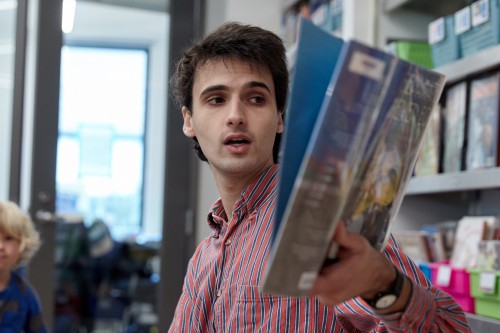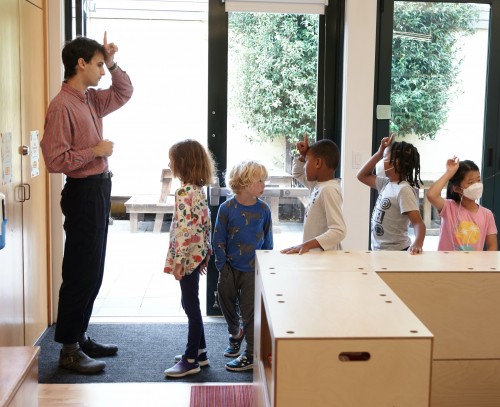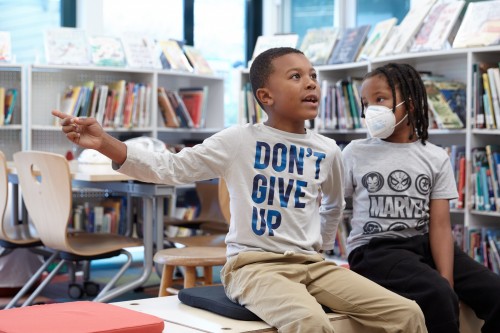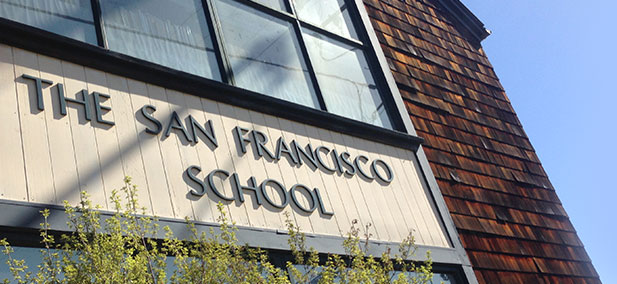A Conversation with Theo Dumothier
Introducing the Dean of the Learning Commons and Library Services
 This fall, we are thrilled to welcome Theo Dumothier, Dean of the Learning Commons and Library Services. The creation of the Learning Commons as well as his role is a culmination of our strategic initiatives and Forge Our Future: the Campaign for SFS. Recently, Carly Reiter, Director of Design, Engineering, and Technology, and Nancy Nagramada, Head of Middle School and Assistant Head of School (who also chaired the Learning Commons Launch Task Force) caught up with Theo on how his school year is going so far.
This fall, we are thrilled to welcome Theo Dumothier, Dean of the Learning Commons and Library Services. The creation of the Learning Commons as well as his role is a culmination of our strategic initiatives and Forge Our Future: the Campaign for SFS. Recently, Carly Reiter, Director of Design, Engineering, and Technology, and Nancy Nagramada, Head of Middle School and Assistant Head of School (who also chaired the Learning Commons Launch Task Force) caught up with Theo on how his school year is going so far.
We’re six weeks into the school year and the Learning Commons is buzzing! How’s it going?
It’s been going really well. One of the most satisfying aspects is that kids know to come into the Learning Commons during unstructured time. I’ve been curating the experience and then standing back as the kids get more and more self-sufficient. Even the younger kids can either check out their own books or ask their buddies for help.
And in the Creativity Cave, it’s been satisfying seeing the space being reorganized and used in new ways. The students are not only intrinsically motivated to be there, but they are asking to contribute – like kids offering to bring in spare batteries from home for the snap circuits.
What is your typical day like? |
|
I usually have two or three programmatic commitments scheduled. It’s about a third of my day, teaching about the library, explaining the Dewey decimal system, reading aloud, or with the middle school students, teaching a tech class or collaborative lesson with other teachers. Another third is being present in the Learning Commons for kids to come in for open use time. I keep the infrastructure tidy and organized and then supervise their unstructured time. I might provide instructions or troubleshoot in the sound booths if needed, but a lot of the time, I am a touchstone for when the kids need me. The last third I spend working on projects, like organizing the library’s collection and ordering new materials. It has been nice having two parent volunteers in the Learning Commons – they have been so helpful. I’m also planning structured and unstructured projects and collaborating with teachers on other projects. |
Offering flexible, unstructured time in the Learning Commons this year is a big programmatic change. How are you seeing that open ended time being used, and who’s using it? |
|
The flexible time crowd changes daily Some days, it’s crickets! I see kids running right by the Learning Commons during their recess. And other days, there’s a huge turnout and the Learning Commons is packed. They use the space in a mix of ways – the 6th Graders are really into board games. There are kids who come in, wanting to read and use the Learning Commons as a traditional library space. We provide the opportunity, and the students can choose to explore. For example, [music teacher] Sofia, the middle school students and I talked about the Canticles of St. Mary in Town Meeting. Each year in a multidisciplinary, multimedia study of medieval music, including the 7th Cantiga de Santa Maria. It’s music and songs recorded in a beautiful manuscript, and Sofia and James obtained an actual-sized facsimile of the original with incredible details like gold leaf ornamentation. [By the way, Sofia and James tell a great story, by the way, of how they had to go to a sketchy corner in Madrid to buy the manuscript in cash!] Usually the lesson is done in the Music Room, but this year, Sofia has been teaching it in the Learning Commons. We’ve been collaborating – she is teaching the musical aspects of the manuscript – from a musician’s angle. And I’m a big history nerd, so I’ve been talking about the continuation of the manuscripts and thinking about books as technology – from a librarian’s angle. And the kids are creating their own medieval illuminations using the Paper app, too. So during the Town Meeting, we invited the middle school students to see the Cantigas in the Learning Commons. And many curious 6th graders came. They were given the opportunity to learn and explore something in more depth in the Learning Commons with me – it’s a mentality shift. I am actively present for them. |
How are you finding the Sound Booths being used? |
|
Students are creating podcast style narrations for tech class – they are such digital natives that they are using them intuitively. They are already very facile with hardware and software. Or for a project with [science teacher] Eugene Stampley, some students recorded a rap using basic mixing software from an online platform – after forty minutes, they had a recording with multilayered tracks. Recently, some of the kids recorded a tutorial, screencast and podcast style, which they shared with their classmates. I’m hoping to offer a podcast elective starting in November – it’ll provide more structure for the time in the booths. I want to include humanities adjacent skills like scripting, layer in storytelling and accompanying sounds. The products will be more polished! Sometimes, learning specialists use the booths for quiet, focused time with their students. Even the staff use the booths for meetings if they’re not occupied – they are a quiet refuge. |
What is the Creativity Cave? |
|
Well, it’s still under construction! Right now, the Creativity Cave is largely a lego building closet, intended to grow to a tinkering or engineering space. We designed its conversion from a walk in closet in the Learning Commons with lots of imagination and Ikea hacks. It calls to them – there are LED lights inside that draw kids of all ages, and it really encourages the story telling aspect to Lego play. The 6th graders are already enjoying it, and the 7th graders are requesting it every day. And the 8th graders’ response was, “Ooooh, the kindergarteners are going to love this!”
|
What’s the range of classes/topics you work with? |
|
I see preschool every few weeks in the Learning Commons, and I see K-8th Grades regularly. I can accommodate groups of different sizes or ages in flexible spaces in a variety of activities with the modular furniture. I move a lot of furniture, but it’s well worth it! Being in the Learning Commons provides the opportunity for Preschoolers to be outside of their building in another part of campus.
For Upper Elementary students, we’ve had more intentional book discussions. For instance, partnering with Angelica [Faustino, 4th Grade Humanities Teacher], we’re building reader identities, using text to world and text to self, through many different activities to process the text! And in addition to the discussion, there are nontraditional ways to engage with books. For example, we will be doing a podcasting piece coming up to make book reviews where we can focus on each step – pre-production, production, and post-production. For the Middle School kids, tech instruction is happening outside of the Learning Commons in dedicated class time, but with resources of the Learning Commons. We’re building tech skills in intentional surroundings and structure. In 7th Grade, we are using code.org to teach HTML and CSS – it’s a big project that teaches them about something that they interact with all the time. We’re demystifying the internet and making it accessible to them. They can access code of any website they see – it’s educational “hacking” in a positive sense of the word. And of course, there’s a digital citizenship component of it, too. As an example, I “hacked” into the School’s website and posted that I would be the next Head of School to reinforce the lesson that you can’t believe anything you see online since anything can be falsely modified. With 8th grade, we are working on 3D design with TinkerCAD computer aided design (CAD) and Sketchup – and it can get very complex. We’re having them create something original – they’re building their dream high schools, down to room arrangements and furnishings. 3D design is everywhere, and they are sure to encounter it in high school and college. It used to be super-specialized and esoteric, but now it is so accessible. One of the exciting parts of this program is that we’re able to put these types of tech experiences in front of every single student to taste it – they don’t have to opt into special classes. And with these intentional exposures across the board, we’re breaking down gender stereotypes and expectations. The kids know that it’s a tool that’s accessible for their future projects. |
The Learning Commons was intended to be modular, as showcased during our Back-to-School Nights and Head of School search events. It’s been a space for meetings and other events, too. And you’re able to create displays for students that correspond to what’s happened – like your display on banned books or Latin Heritage Month. Do you think the modular concept is accomplishing what was intended? |
|
I can create zones and different seating or work stations. Mostly, I use the pieces to separate spaces, create nooks that can separate half groups into even smaller groups but then bring them together for a bigger discussion. I’m still figuring out how to maximize it, like recently when I split the 1st Grade class into three smaller groups. The design is intuitive – and everything is on wheels. Yes, I think it’s working! |
What are your aspirations for the Learning Commons? |
|
One day, I want to move the potential of the Creativity Cave into an instructional context. Free play is great, but it would also be great to host smaller groups with engineering or stop motion workshops, maybe in collaboration with Jalen [Allen ’08, Elementary STEAM teacher]. So I’d really like to integrate the Cave with the programmatic side and continue to build skills while at play. With our modular furniture we can move pieces like bleachers to utilize the space around the Creativity Cave. Another big aspiration that I have for the Learning Commons is to use the space to host events that bring in the community. A major piece of this involves hosting author events. Our first author event is already scheduled for October 28, and I couldn’t be more excited! Local author Jetta Martin is coming to discuss her new book about the Black Panther Party with the middle school. She wrote the book for teens because she sees young people as powerful activists, so it’s bound to be an inspirational talk! There’s also an illustrator event in the works for the elementary grades in the works, so stay tuned. A parent actually turned me onto this particular illustrator, which presented a wonderful opportunity to connect with families as well. Of course, I’d love to host events that involve the whole SFS community in the future. I have a few authors in mind that could animate a superb event for both students and parents, and I’ve been connecting with other independent school librarians in the Bay Area for tips on how to make it happen. Keep an eye out for those events because they’ll be a fantastic way to connect through the Learning Commons! |
Theo would be happy to have more parenting adult volunteers in the Learning Commons. And he is happily accepting more Lego donations for the Creativity Cave (and offering amnesty for overdue books – no questions asked!). Book donations are not currently accepted, but stay tuned for the annual book drive at SFS for the African Library Project!
Posted October 16, 2022
 Especially for those who aren’t naturally drawn to the book side of the Learning Commons, they explore and get excited about creating stories with Legos. There’s a green screen, stop motion animation, and eventually there’ll be robotics, too. There are removable drawers full of Legos that can be taken out of the Cave to use, too. I just had a student who is not an enthusiastic reader who loved playing with the legos in the Creativity Cave, and when he emerged, he was asking for help to find books about Legos!
Especially for those who aren’t naturally drawn to the book side of the Learning Commons, they explore and get excited about creating stories with Legos. There’s a green screen, stop motion animation, and eventually there’ll be robotics, too. There are removable drawers full of Legos that can be taken out of the Cave to use, too. I just had a student who is not an enthusiastic reader who loved playing with the legos in the Creativity Cave, and when he emerged, he was asking for help to find books about Legos! For Lower Elementary students, I focus on library instruction and book shopping, trying to spark interest in literacy. Within our time together, I try to draw them in, teach them skills (like “What’s a catalog?”), and present the Learning Commons as an information space!
For Lower Elementary students, I focus on library instruction and book shopping, trying to spark interest in literacy. Within our time together, I try to draw them in, teach them skills (like “What’s a catalog?”), and present the Learning Commons as an information space!
